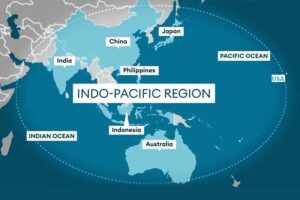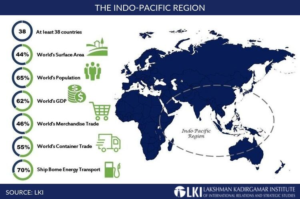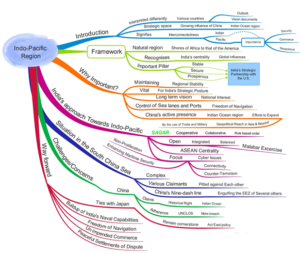Connecting India’s East with the Indo-Pacific
Why in News?
The Indo-Pacific Conclave was organised by the US Consulate General and the Asian Confluence, a think tank that was leading in the study of India’s Northeast.
Importance of North East India
- The Northeast comprises seven ‘sisters’ or States and one ‘brother’, Sikkim.
- The eight states of North East India are blessed with scenic natural beauty, rich biodiversity, rare wildlife, historical sites, distinct cultural and ethnic heritage, and warm and welcoming people.
- The region offers unforgettable Wildlife Tourism, Tea & Golf Tourism, River tourism, Religious & Spiritual Tourism, Heritage Tourism, Cultural & Culinary Tourism, Adventure Tourism, Agro & Rural Tourism, and Offbeat Destinations.
- Northeast India is home to many wildlife sanctuaries like Kaziranga National Park famous for the one-horned rhinoceros.
- The mighty Brahmaputra flows through the length of Assam where tourists can enjoy memorable river cruises and the flowing rivers of Arunachal Pradesh which feed the Brahmaputra offering incredible white water rafting experiences.
- The region is endowed with diverse tourist attractions.
- Each State has its own distinct features and has great potential for accelerating tourism growth.
- The Geographical Location of the North Eastern Region (NER) stands as the most favorable location to focus on the implementation of India’s act East Policy.
- The Region is the gateway to South East Asia. Therefore, the development of the communication infrastructure of the northeastern region is very important so that it can be linked to the neighboring South East Asian countries of Bangladesh Myanmar, Thailand, Malaysia, Vietnam, Bhutan & China.
Governments Efforts
- The integration of Northeast India into mainstream Indian life has been on the national agenda from the very start of India’s journey as an independent nation.
- It has been witnessing transformation as it heads towards better security conditions and development.
- Recent participation in policy conversations in Imphal, the capital of Manipur, one of the four States bordering Myanmar helped in clarifying local needs and priorities.
- Since 2018, India’s ‘Look East’ and ‘Act East’ policies have moved into the phase of Indo-Pacific policy and strategy
- The new Scheme, PM-DevINE, was announced in the Union Budget 2022-23 to address development gaps in the North Eastern Region (NER).
- PMDevINE is an additionality to the quantum of resources available for the development of the NER. It will not be a substitute for existing Central and State Schemes
Existing Issues
- The core issues behind the insurgency have remained unresolved.
- The pernicious phenomena of smuggling, drug trafficking, transnational border crime, insurgent activity, and the influx of refugees (from Myanmar) represented serious non-traditional threats.
- China was viewed as a ‘constant player’ behind these nefarious activities.
- This has necessitated vigilance and strict action by the Assam Rifles and other security agencies.
- Others representing local communities, however, expressed concern over the insensitive handling of those engaged in lawful exchanges with the neighbouring countries.
- The region has always been seen to be somewhat alien and needing assimilation, which found (and finds) reflection in administrative terms too.
Suggestions and Concluions
- The Northeast is on the right path to concentrate on economic development.
- More is awaited through improvement in roads linking northeastern towns and job creation for thousands of graduates produced by local universities.
- Accelerated development requires increased investment by Indian corporates and foreign investors as well as better management.
- the strategic and business community should contribute to crafting a concrete blueprint for leveraging opportunities relating to commerce, connectivity, and human capital development.
- There is a need to ensure adequate security, speed up economic development, and connect better with the rest of India and select South Asian and Southeast Asian nations.
- Moving beyond geopolitics and geo-economics, neighbours should focus on “the geo-cultural dimension” of the Indo-Pacific.
- expanding the reach of cultural diplomacy and people-to-people cooperation through greater educational exchanges, tourism, and trade is desirable.
- The member-states need to invest more in the Bay of Bengal Initiative for Multi-Sectoral Technical and Economic Cooperation (BIMSTEC) to enhance its effectiveness.
- in implementing India’s Indo-Pacific strategy, voices from Northeast and eastern India must be heard.
- Thus, beyond ‘Look East’ and ‘Act East’ lies ‘Think and Relate East’, especially within our own country.
Mains Practice Question
- Do you agree that the North-east Region of India is entering a phase of rapid growth and stability? What steps has the Government taken in this regard?






